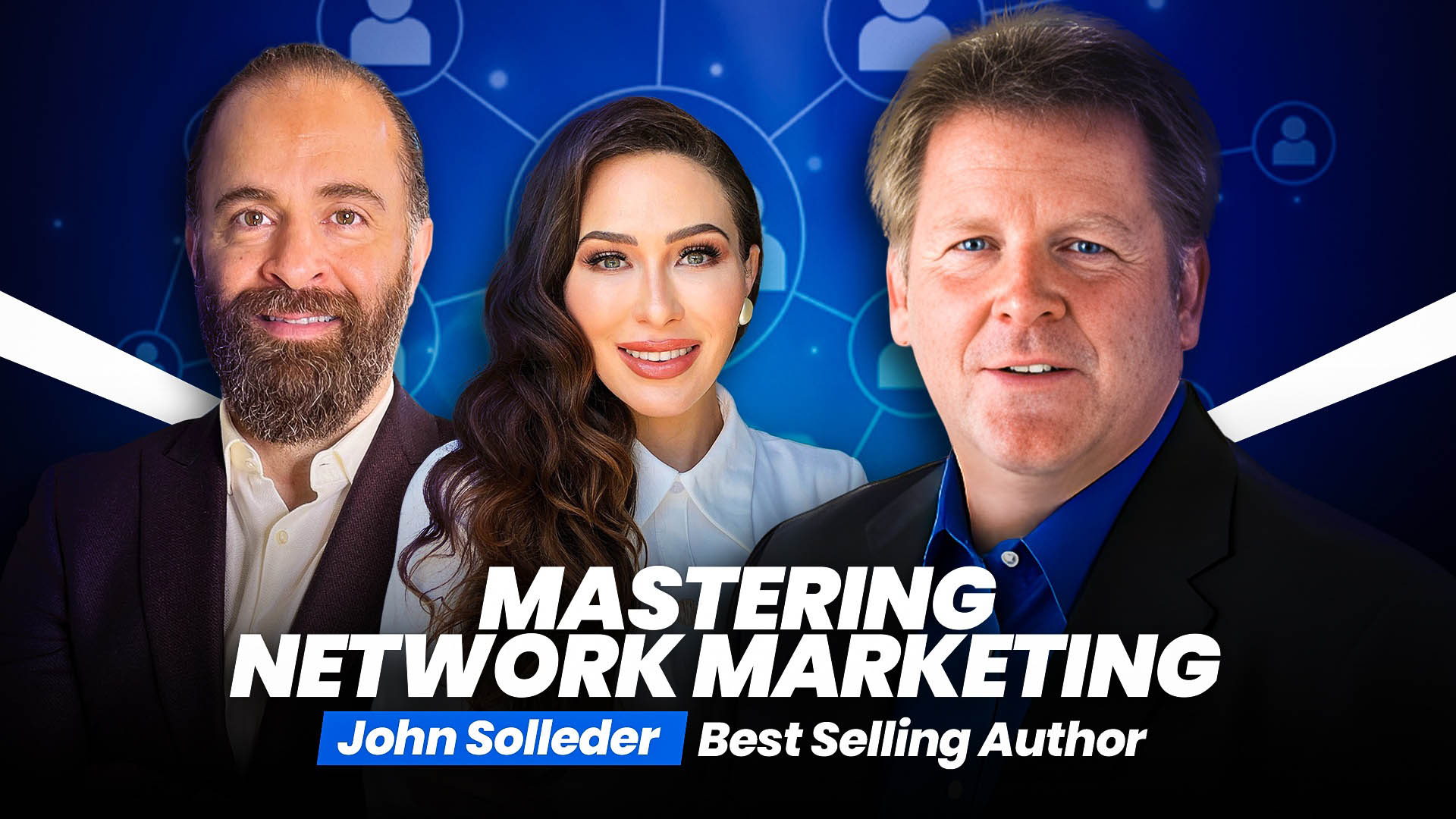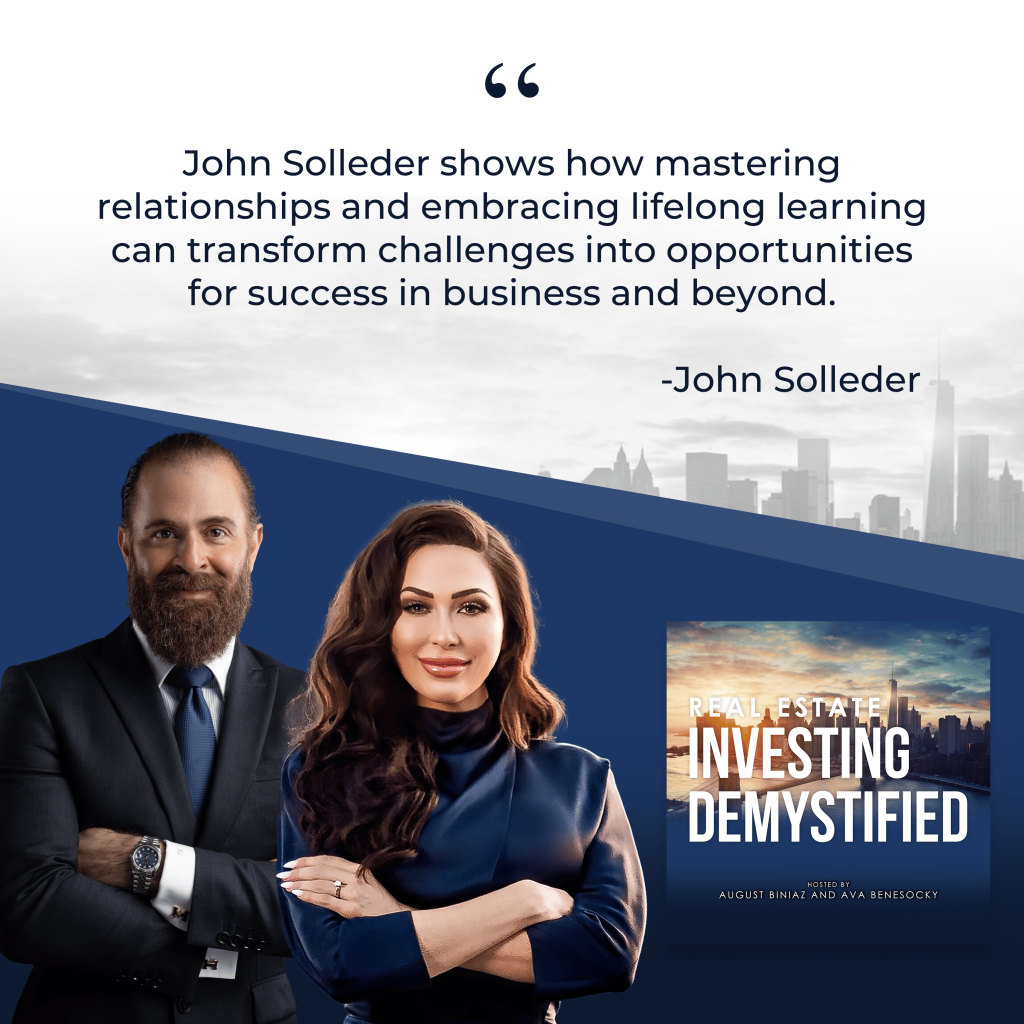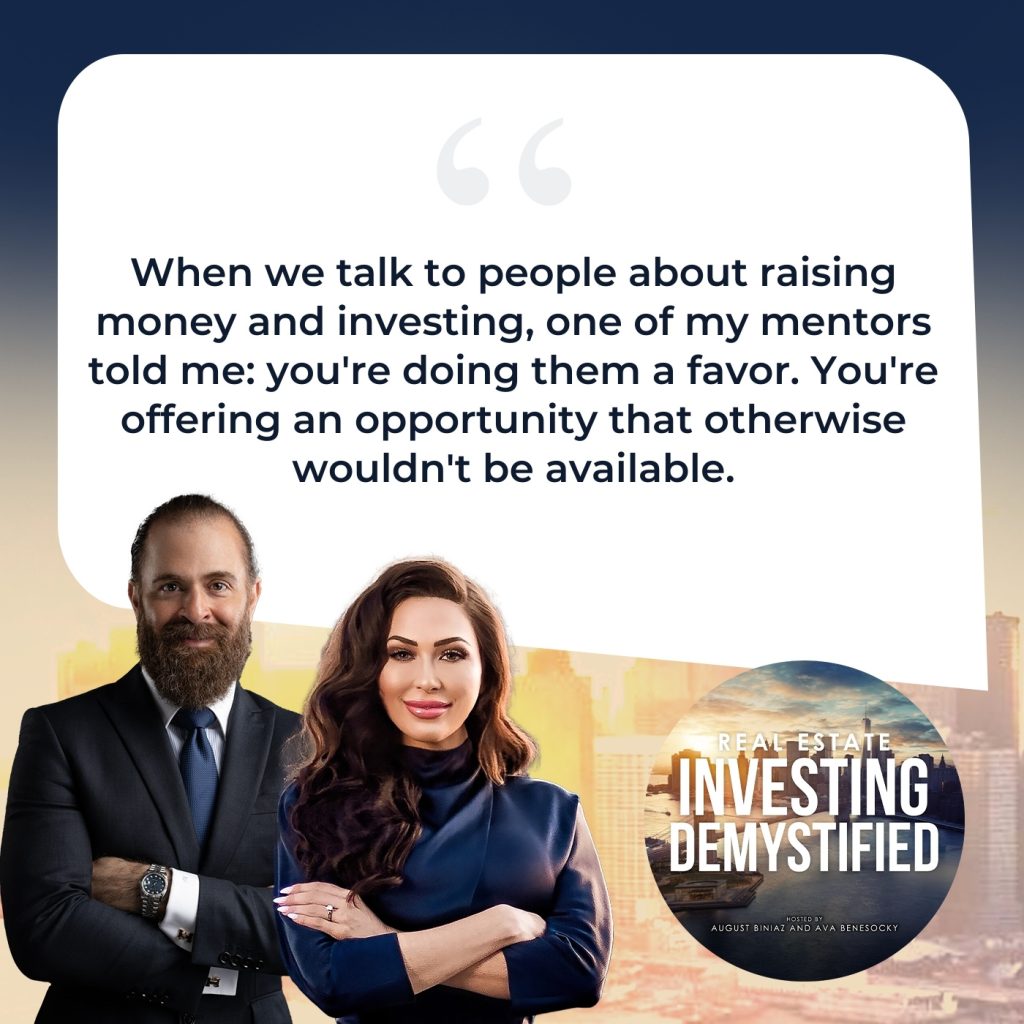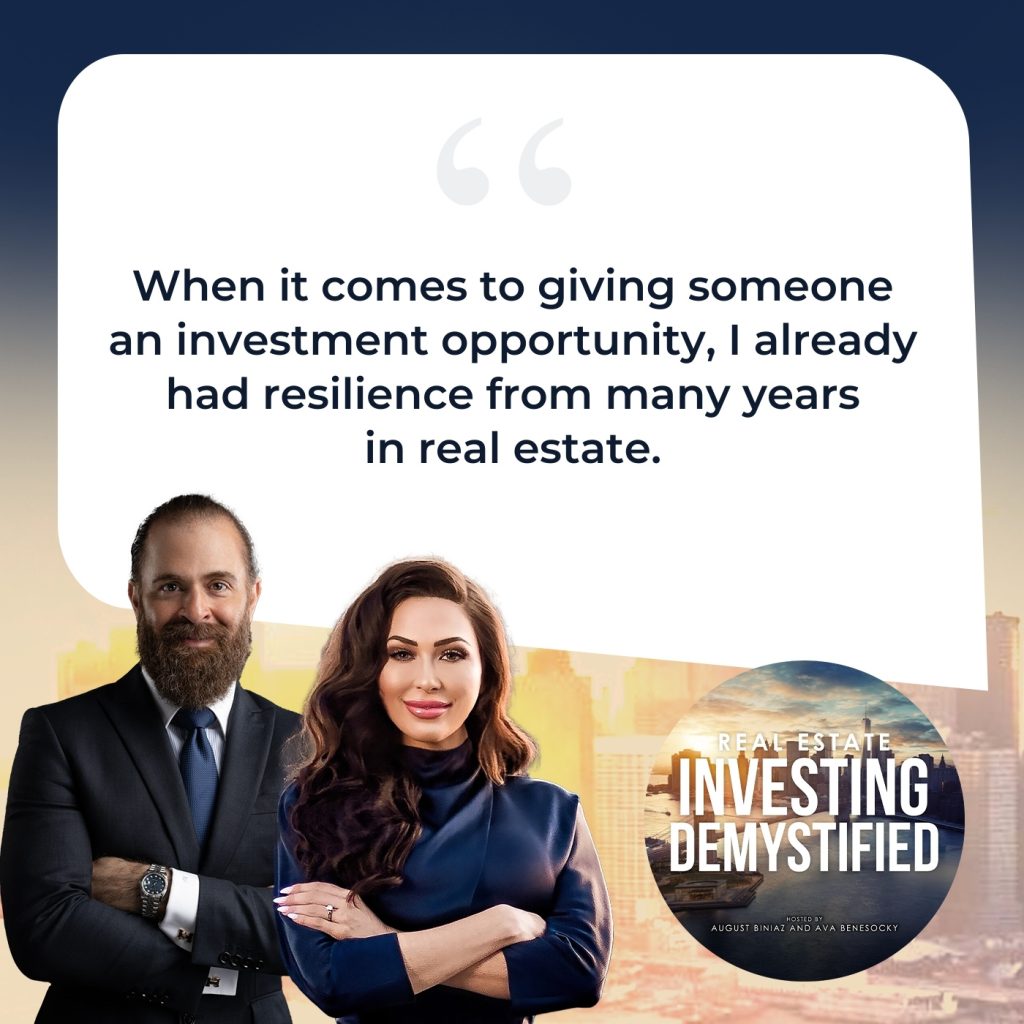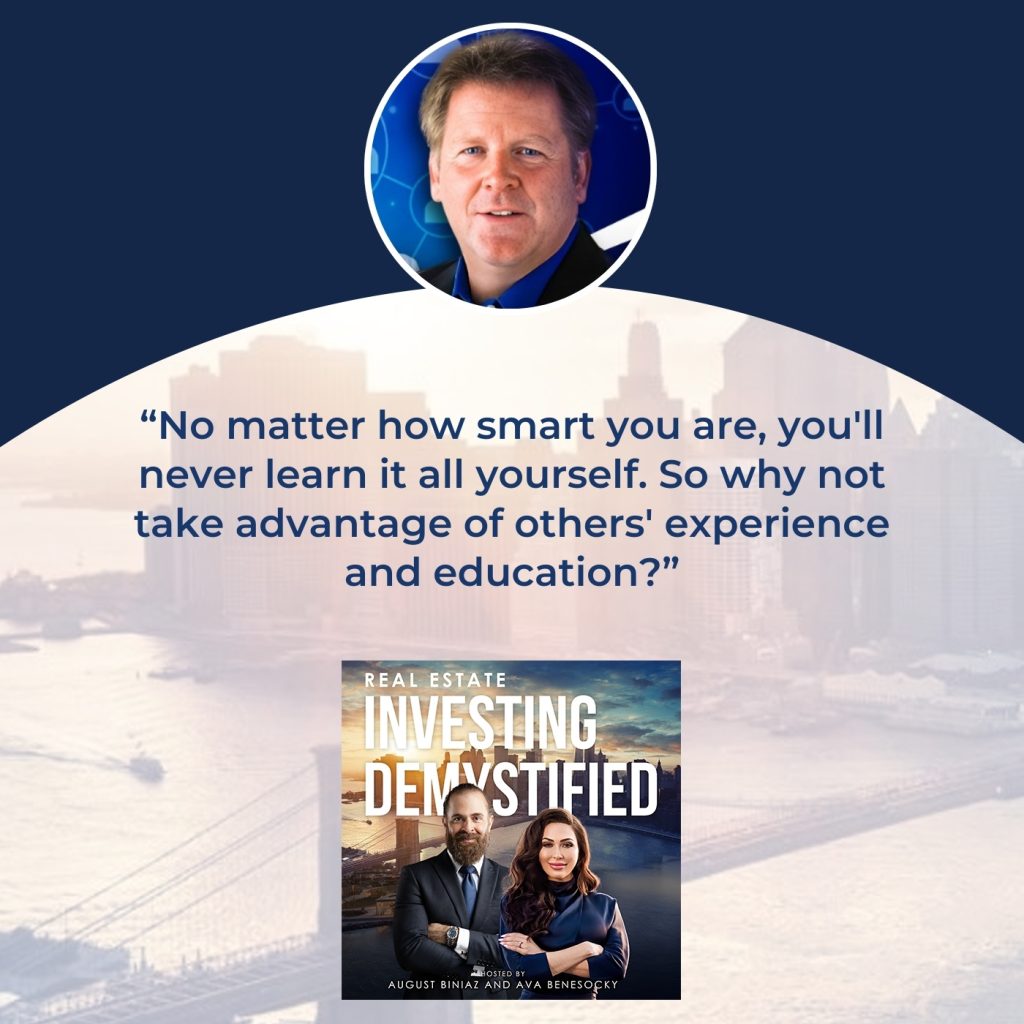Success in network marketing isn’t luck—it’s built on mentorship, mindset, and meaningful connections. Best-selling author John Solleder shares hard-earned lessons from decades in the industry, including why rejection is never personal, how to tailor conversations to what truly matters to people, and the strategies that turn “nos” into “yeses.” From Jim Rohn’s timeless wisdom to the practical importance of note-taking, mentorship, and resilience, John reveals the principles that fuel long-term success in business and life.
Get in touch with John Solleder:
Website: https://www.johnsolleder.com
If you are interested in learning more about passively investing in multifamily and build-to-rent properties, click here to schedule a call with the CPI Capital Team or contact us at info@cpicapital.ca. If you like to co-syndicate and close on larger deals as a general partner, click here. You can read more about CPI Capital at https://www.cpicapital.ca.
#avabenesocky #augustbiniaz #cpicapital
—
Watch the episode here
Listen to the podcast here
Important Links
- John Solleder
- John Solleder on YouTube
- Shaklee Corporation
- Mary Kay
- The Seasons of Life
- The Power of Positive Thinking
About John Solleder
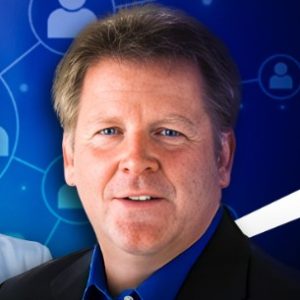
More recently, John has expanded into podcasting and AI, growing his brand and influence worldwide. Beyond business, he’s a lifelong athlete, a black belt in both Judo and BJJ, a health enthusiast, and a big believer in longevity and wellness.
Mastering Network Marketing With Best-Selling Author, John Solleder
Everyone, welcome back to Real Estate Investing Demystified.
The Survivor Fallacy: Early Investor Relations Challenges
Welcome back, everyone. I’ve been thinking a lot about the origin of CPI and the beginning days. There’s this concept, a lot of times in business and in life, really, it’s called the survivor fallacy. Sometimes you see the people who’ve done really well, and you think that’s really how it is. When we started out, particularly when it came to building the investor relations infrastructure, when it came to connecting with investors and basically raising the equity needed for deals, it seemed to be very easy. You would listen to books and stories about Steve Shortsman starting Blackstone and how, on his first fund, he was able to raise a billion dollars.
I’m like, “That’s easy billion dollars, we can probably raise $10 million on our first deal.” It didn’t turn out that way. It was much more difficult. We really cut our teeth on this concept of raising money, but it goes down to building relationships, connecting with people on a different level, especially when you don’t know someone. Just going up to them and saying, “We’ve got a great real estate deal. These are the economics. Come and invest $100,000.” It’s a big ask. You’re not selling a service or a product. You’re really offering a partnership. Very interesting.
I was going to add to that really quickly. I’ll never forget this. You and I looked at each other. We worked so hard to get all these people in our database. We’re like, “We have a couple thousand people in our database. We can easily raise $5 million.” We only need 100 investors, let’s say, right? I’ll never forget the first time that we had a deal. It is, I’d say, one of the most difficult things to do in real estate private equity is raising in life.
My mom always says, “Do you want to know your real friend? Ask him for $1,000.” Like, “Man, do you have a $1,000?” You’ll know who your real friends are. Like, “Somebody’s there on the call. Man, how are you doing? Can I borrow it? Hello?” Life is very interesting that way. We learn lots. We have a great guest on. I’ve been on our guests’ podcast. He’s doing the favor and coming on ours, but he’s got great experience in life and business.
I want to talk to him about his background in wrestling as well. There’s a little connection there because Persian people, Iranian people, are the top five wrestlers in the world, possibly even the top three. We’re going to talk about that, but relationship building and how to manage that. We’re going to get into all of that and tell our audience a bit about our guest.
Before that, I guess I have a question for you. Can we switch the show up a bit to talk about health and longevity?
He would do amazing. Probably get millions and millions of views.
Our guest has some tricks of the trade for health and longevity as well. I’m obsessed. August knows how obsessed I am. I’m a mother of two. My main goal is like, how do I feel the best, look the best, and have the most amount of energy I can every single day to perform at a high level so I would. I’m just kidding. We’ll have another show later.
In the last baby, I saw you going from a welterweight, 147, all the way up to a super heavyweight, 205, when you had our kid, and you will work your way back down to a welterweight in a matter of months. You are a champ in my view.
Now, seven months later, I’m in better shape than I was before.
You did it better than Manny Pacquiao. He’s an eight-division world champion. You went way more than that, but let’s get to the show.
We’re excited.
We’re joined by John Solleder. Now, John is a best-selling author, an entrepreneur, and a global speaker with over 40 years of experience in sales and business. He’s built success at the highest level in multiple organizations, consulted for the top direct-selling companies, and spoken in more than 60 countries. Most recently, John has expanded into podcasting and AI, growing his brand to influence worldwide. Beyond business, he’s a lifelong athlete, a black belt in both judo and BJJ, and a health enthusiast and a big believer in longevity and wellness. Welcome to the show, John. We’re excited to have you here.
Welcome, John.
Thank you so much. I’ve done those weight cuts, but for powerlifting, I never had a baby. I’ve watched my wife and other women go through that. Not fun. Certainly on the back end, but the babies have certainly worked. Congratulations on two beautiful children, by the way.
Network Marketing: A Crash Course On Its Evolution
Thank you so much, John. John, I want to get right into things. You’re in a very interesting industry, network marketing, also known as multi-level marketing, which is a controversial business model. However, it’s very popular. Many industries and great companies have used this business model to really build and grow. For example, EXP Realty is a company. They’re not only making money from you being a broker, but they say, “Listen, if you bring on other brokers, you’re going to get a piece of their pie, the business that they bring to the table. Why don’t you give us a crash course on network marketing, please, and how it all works?
Network marketing morphed out of the direct selling industry. Direct selling has been around for companies way back, like Avon and Tupperware, for example. That sold product, basically, like a woman would go to work, for example. At her lunch hour, she would get together with her girlfriends and say, “I’ve got this lipstick, I’ve got this shampoo, I’ve got this skin cream, etc.” If they bought it, the woman would make some extra money that they used to call pin money. They called it pin money because they used to pin it in their blouse so their husbands wouldn’t know about it. True story.
That’s how the direct selling industry started to grow way back 40s, 50s, and even before that, the way. It goes back to the turn of the century, was the very first direct selling company out of Mississippi. As a matter of fact, LeBron James has made a documentary about the woman who started it, who was actually an African American woman. On top of it, she was way ahead of her time in so many different ways as a woman and an African American on top of it. That business is still around, by the way, it’s not direct selling anymore.
It’s sold through Amazon. That’s how the industry started. You had really four primary companies. In 1956, you had Shaklee. Shaklee was started by a doctor. He was a chiropractor in California, and he started that company primarily for his kids to have things to take that he felt were safe, and also to have biodegradable types of soap suds, and things that if your kid got into it, they weren’t going to die. If you’re washing your car and your kid says, “Let me take a drink for whatever reason.”
That’s why he started his company way back. In 1958, the Amway Corporation got started and got started as a result of two people from a company called Neutralite, which was a vitamin company that decided it didn’t want to be in business anymore. They said, “We’ll buy the brand.” That’s where the great Amway Corporation started, which includes all of those companies, by the way, still in business. The Amway Corporation is owned by the founders’ children, the Shaklee Corporation, by an investment banker, by the name of Roger Barnett, who’s a very successful man in his own right, who bought that company a number of years ago.
In 1963, a disgruntled Stanley tool company executive, a lady by the name of Mary Kay Ash, decided to start a skincare company here in Dallas called Mary Kay. It became the company that created so many extremely successful women. It was a company for women. Were guys in it along the way, but generally the guys were in the back and the women were in the front. It was the first company of its kind like that. It continues to this day, right down the street from my house here. They continue to grow exponentially around the world and are doing some great things.
In 1980 was Herbalife. Herbalife was the company that started to change the industry with respect to the payment compensation model, where just about everybody at that point was part-time in network marketing in the early ‘80s. Because of the compensation model, the way that they got paid, a three-level compensation plan instead of one level. Essentially, people started to be able to make a full-time living in some cases. That’s where your first full-time network marketing people came about in the ‘80s was with Herbalife changed the course of history, where network marketing became a, in my case, for example, a full-time business model.
However, here’s the caveat. Even in 2025, as we’re almost to 2026, it’s not really intended to be a full-time business model. It’s intended to be a multiple-source of income business model. It’s supposed to be for your real estate investments. It’s supposed to fund your retirement. It’s supposed to fund your children’s education. The car fund when the car breaks. The rainy day fund, the vacation, whatever.
We’ve all got different reasons for money, obviously, in different stages of life, and that certainly changes. That’s what it’s really intended for. It doesn’t mean it cannot be a full-time business, but sometimes people think they’re full-time, but they’re working part-time hours or getting part-time income results. They say, “I’m full-time network marketing didn’t work.” No, you didn’t work. It’s the reality of it.
For most people, my suggestion is, whatever company you’re in, keep it part-time, keep it as an extra source of income, keep your benefits from your job, so to speak, and do network marketing a few hours at night and on the weekends and build that business up over time. If it replaces your full-time income, terrific. If it never does, use it as an investment model to fund your future. That, to me, is the best use of a network marketing business.
I was very familiar with Avon, Amway, and Mary Kay. My grandma used to sell Mary Kay back in the day, and I was a little girl, and I’d always take the extras that she couldn’t sell. It was always the very blue and the pink eyeshadow. I thought it was so cool.
From College To Herbalife: John Solleder’s Entry Into Network Marketing
I guess next up, tell us how you got involved in this world.
I was about to graduate from college in 1983, and I was in Virginia. I was at a thing called the Samba tournament. Samba was Russian wrestling. It’s a combination of freestyle wrestling and judo. I competed in this tournament. One of the guys I competed against was actually a Marine Corps recruiter. He said, “What are you going to do when you graduate?” I was graduating the next month. This was April 1983.
I said, “I’m probably just going to look for a job.” He said, “Why don’t you consider the Marine Corps?” I come from a long line of military people on my dad’s side and my mom’s side of the family. I said, “Why not? I like discipline. I like to work out. If I can do both and get paid by the government, why not?” I was going to do that. That was on the weekend. During the course of that week, a guy who I had wrestled with in high school came into the gym I was working out at, and he told me about Herbalife.
This was April 18th, 1983. He was a couple of years older than me. He said, “I started my own business. You can join me. It’s going to cost you $32.” You were talking about a $1,000 a minute ago, August? $32 I didn’t have in 1983. I said, “I got a checkbook. If I can write you a check, and you’ll hold the check for a couple of days. I’ll be able to make it good.” I was working part-time. I said, “I’ll be able to make it good on Friday.” He said, “Yeah, no problem.”
I joined that business, and that night, after doing my schoolwork at 10:00, I took out what they called the Career Book. I still have these, by the way, still with my aim, but I still use yellow notepads. I started making notes, and by 4:00 AM, I made my first million dollars. Just like real estate investing on paper, it all worked really well until you get to the reality of talking to people. It doesn’t quite work that easily.
In real estate, call it a Pro forma. You created a Pro forma.
I had circles of 5%. Everybody I was going to talk to was going to get involved. I didn’t know that wasn’t going to happen, even all these years later. What happened was interesting. It’s a long story, but I’ll tell it as short as I can here for the sake of time. May 18th, ‘83, one month later, two things happened. Number one, I made $800 part-time. Now, in 1983, nobody had credit cards. The people who bought the product paid me cash or checks. I had $800 in my wallet. Despite the cost of goods, I still made $800, which was a lot of money in 1983.
The second thing that happened on May 18th, 1983, was that I graduated from Seton Hall University in New Jersey, and Ronald Reagan was the commencement speaker. Now, the economy in ‘83 was not great. We were still coming out of the turmoil of the Carter years and just total mismanagement of government, 18% interest rates. People weren’t buying cars. They certainly weren’t buying houses. We were still recovering from the mismanagement. Long story short, Reagan talked about the fact that in 1932, when he graduated from college, the economy was similar to the depression years.
He went back to being a lifeguard after he graduated from college. A gentleman at that swimming hole, where he was a lifeguard in Illinois he gave him some advice. He said, “How do you get successful?” He’s asking this successful guy, and the guy says, “You find a mentor who can teach you a business that you’re passionate about.” In Reagan’s case, he liked to publicly speak. He became a broadcaster for the Chicago Cubs, one of their affiliate baseball teams.
I think it was in Iowa. Lo and behold, somebody from Westinghouse hears them and says, “This guy’s got a great voice. Let’s bring them out to California.” They do all these tests with them. He winds up doing commercials and voiceovers and all that stuff. As they say, the rest is history. I listened to the president that day, and I’m thinking, “I’ve got mentors.” I’m still looking for a job, but I’ve got people mentoring me in this business who know what they’re doing. Some of them are making $10,000 a month already in 1983.
That was a lot of money. I’m like, “If they’re teaching me the business, great.” Fast forward another 30 days, roughly. I don’t remember the exact date in June, but I went to my very first business meeting. Never been to a business meeting in my life. Didn’t even have a suit and tie. I had the occasional Christmas suit to wear to church on Christmas Eve. Otherwise, I never wore a suit. I went out and I bought a cheap suit, and I went to this meeting in Hartford, Connecticut. The guy doing the meeting said these words.
He said, “For things to change, you have to change. For things to get better, you have to get better.” It was like somebody slapped me across the face. At that point in my life, I was still into making excuses. The economy, the president, my parents, my sisters, my girlfriend everybody else were at fault for why I was not achieving what I thought I should be achieving at that point in my life. What I recognized by that statement, that the great Jim Rohn had put those words together. Jim wasn’t at the meeting.
For things to change, you have to change. For things to get better, you have to get better. Share on XI don’t think Larry Thompson said those words, but when I heard those words, it was that wake-up call for me to get to the library, the free public library. Today, we’ve got Google and all these AI and all these things. Back then, we had these things called libraries. I went to the library and I started reading Earl Nightingale and Dr. Norman Vincent Peale, and Mary Kay, for that matter. Other people who had been super successful in business and in life. I said, “Anything in life you can study, you can become more successful at.
Maybe not as successful as that individual, but you can learn from their mistake and also from their successes. I started to work on me as the brand, not on my urban life business, not on any other business I would eventually engage in, but I always worked on me. Even at 64, I’m still working on me. I’m still getting better. I’m still reading every day. I’m still listening to podcasts every day. I’m still picking people like yourselves who are successful brains every single day.
I talked to two different people that one made $2 million in his business last year, indirect selling. Another made over $3 million in his AI business. I talked to successful people. Why? I’m like a sponge. I’m still learning at this stage of my life. That was what happened. Those April 18th to that meeting in June was an evolutionary process for me. It was the proverbial wake-up call that said, “You can achieve some things in your life.

Network Marketing: Achieve things in life. Stop making excuses, get to work. Read the books, go to the seminars, ask the questions. Make your life successful.
Stop making excuses, get to work, read the book, go to the seminars, ask the questions, and make your life successful.” That was it for me. It changed. By the way, it took me six more years to make my first million dollars. I’m like an overnight success story, seven years in the process to get there. At the end of the day, it was so formative. To this day, I still teach some of those early lessons to people.
I love that. I was going to say there’s a, there’s quote from Charlie Brown, and it says, “Good things come to those who believe, better things come to those who are patient, and the best things come to those who don’t give up.” That reminded what your story there reminded me of that quote from Charlie Brown.
Great background. Incredible background.
The Art Of Building Relationships & Sales
Let’s switch the conversation a little bit and get into relationship building in August.
That’s the next step of his journey, really. He’s gone there. He’s gained the knowledge needed, and now he’s in this industry, which is very relationship-based. It fits right in.
As August mentioned at the beginning of our show, our business is in real estate private equity. It’s really a black and white business model. We had to find good deals, and we partnered with investors to fund the project. I wanted to talk about, obviously, relationship building, sales, investor relations, and communications.
To date, I’ve raised about $30 million for our real estate projects from high-net-worth individuals and family offices. Because of the trust that I built with these individuals and the relationships that I built with them, the relationships that I formed. I wanted to establish a correlation between seeking investors like we do at CPI Capital, as there’s a compliance component in the finance industry. Talk about searching for clients.
We seek investors, which is different than selling like a lower-pitch deal. I was going to say an example, our investments, minimum investments, 50K. It’s much different than trying to get somebody to subscribe for, say $29.99. From your experience, John, and the strategies that you’ve used, what do you feel are some similarities and differences in strategies between raising capital and then selling a product? How do you build connections, start conversations without becoming a pest? Talk to us about your journey and all of this.
I learned a long time ago from Tom Hopkins, another one of my many mentors, who’s a real estate guy like yourselves. I learned from Tom’s tie downs, and I came up with a tie down which was really worked very well for me. That was this. “Could I share an idea that’s been a benefit to,” and I fill in the blank. If I’m talking to real estate people, can I share an idea that’s been a benefit to realtors? If I’m talking to an insurance guy, can I share an idea that’s been a benefit to insurance people?
If I’m talking to an accountant, same, lawyer, same, doctor, same. What that does is it personalizes it to their professional life. Where they say, “Tell me, you worked with people in my industry. Tell me what’s worked.” That idea of sharing an idea, because the backup to that is what if the person says, “No, you cannot share an idea.” I said, “I don’t want to say this, but are you closed-minded? Do you think every good idea has been invented?”
There was a time in the United States when they almost closed the patent office, believe it or not, because they thought every good idea had been invented a while ago. Since then, we’ve got color television sets, AI, computers, cell phones, and multitudes of other things. Come on. To get that, I call it verbal tennis. It’s like I hit the ball over the net. They hit it back. It’s to get that dialogue going where we break down that barrier and they go,” What is it? What do you have?” To me, that’s how I built a lot of relationships with people is just by asking them, “Can I share an idea?” That’s been a benefit to people, assuming I know what they’re doing, by the way.
You tailor it to that individual and their background. In our space, we call it figuring out the person’s pain point. A lot of times, we were talking to a lot of physicians, and they make a lot of money. Their issue is not money because they’re already making a lot of money. Us pitching them, you can invest a $100K and in a couple of years, in five years, double your money, or in a few years’ time and a half that. That’s not a big part of what they want to do, making money. More is about this idea of time freedom because their time is so scarce. We’re like, “If you have this alternative source of income, that will reduce your need to having to work so much.”
“We’re retiring earlier.” They don’t have to work the hours until they’re 65.
I even go one other step on that, depending on how the conversation goes. Some people, it’s like, “Tell me what you got.” Others, it’s like, “How can this help me?” I’ll ask them personal questions like “By the way, I sold insurance at different points in my life too.” I’ve always kept my foot in the insurance business. First, Herbalife had a problem with the FDA in ‘84. I got into the insurance business for three years. I’ve always stayed licensed because, being in the insurance business, you stay up on economics. You cannot not.
If you don't prepare, it's going to be a problem. Share on XYou get all this data from all of these great company actuaries that tell you all these things going on. Anyway, that being said, I always say to people, depending on their age, if I’m talking to a guy my age, I talk to them about retirement income because that’s their sweet spot. I’m not going to talk to them about a college education fund for their kids. Their kids are grown. Their kids are 40 years old in theory. I’m going to get it to their sweets. I have you saved enough for retirement between whatever your company pension is and your social security. “I’m a couple of thousand dollars a month short, John.”
If I could show you a way to make up that difference with a few hours a day around your schedule, around your golf game, around your doctor’s appointments, around whatever, it’s like, it gets the conversation going. It also gets their mind going. I can see that. It’s like, I’m not talking about my product right now, my compensation.
I’m not getting into any of that. What I’m doing is I’m creating for them the environment where they see themselves doing something with me to build a business part-time that’ll make up for something that they’re deficient in. If I’m talking to a couple in their twenties, and then they just had their first kid, I’ll say to them something like, “Listen, I can show you a way to send junior to Harvard or McGill or wherever, Stanford, when the time comes, who knows what it’s going to cost.”
Already astronomical and probably more astronomical might be free. I don’t know. At the end of the day, here’s what I can tell you. If you don’t prepare. It’s going to be a problem. At the end of the day, if I could show you a way to create that college education fund for little Joey over here, great. If little Joey doesn’t go to college, it’s your money.
You tailor-make it. The concept is the same, but you tailor it to each individual you’re dealing with. I don’t want to over dissect this, but let’s touch on one more thing is that I had much more difficulty with this than Ava did. I felt when we first started out that my reaching out to people and asking them to invest with us was as if I were asking them for money. Obviously, I’m a man, I’m proud, I don’t want to ask people for money, but that’s part of our business. We have to talk to people about raising money and investing.
Someone who mentors told me that you’re doing them a favor, you’re offering them an opportunity that otherwise wouldn’t be available, so look at it that way. That helped a lot. It is still difficult to get on a call with someone and hear no. Talk to us about the idea of pitching, meeting with people, but hearing no, how do you master up the courage to reach out to that person again? Talk to us about the confidence building, if it or what it is called, where do you have enough motivation to talk to people about investing with you, or buying from you, or partnering with you?
Conquering The “No”: Building Resilience In Sales
First of all, and your mentor is right on that one. I’m doing them a favor. If I can show them a way to make a couple thousand dollars a month part-time, I’m doing them a favor because here’s what I do know. What’s their alternative? Go work at Walmart, stand on their feet as a greeter, and say hello to people all day like this. After a while, your brain’s going to turn to mud, or some other thing, or maybe physiologically they cannot do something like that.
They cannot stand on their feet for eight hours a day or whatever, right? I think they do let them sit. The point is, what’s their alternative work at a fast food restaurant? AI is taking those jobs. At the end of the day, those jobs aren’t even going to exist. They’d better do something. They’d better take the responsibility to do something that I can help them do because I’ve guided tens of thousands of people over 40 plus years successfully.
As long as they’re willing to do some work, obviously, they need to show up, but they’re not going to need to kill themselves in direct selling. It’s like, it’s a clean business. You’re not out digging ditches. I can show them that, but the second point on that, what happens when I do hear no? I just always look at it like this. If I looked at it and I said, every time I make a sale, just to keep it simple, let’s say I make $100. I talked to ten people in a day. It’s one of my Ten Penny Principle, by the way, kicks in.
We’re going to get into that in a moment, by the way, but keep watching.
I talked to ten people, nine say, “Nope,” but one says, “Yes, I made a$100.” At the end of the day, what did I go to the bank with? A $100. The nine people who said no, in theory, made me $10 every time they said no. The guy who said yes also made me $10. I still got the same result of a hundred dollars. If I need to make a thousand dollars, I need to up the numbers. You see, if I need to make $10,000, I need to up the numbers more significantly.
Depending on what you’re selling. Real estate obviously has a much higher commission, but you’d sell less of it in terms of volume and numbers. In network marketing, I need to sell more people, which means, if I’m making a hundred dollars a sale and I need to make $200 to make my car payment this week, guess what? I need to talk to twenty people. They’re going to get two that are going to buy, there’s my $100 twice. There’s $200, right?
I can hear it so that they have realistic expectations, but they have to have, by the way, I don’t care if you train a realtor, you’re training in network marketing people, you’re training insurance agents. They have to have realistic activity goals. I looked back, and I found one of my old daytimers from 1985. When I really hit the road in my insurance business and I did really well. I was like the rising superstar in the company, and I was in New York.
I got recognized all over the place. Broke those guys’ hearts when I decided to go back to network marketing full-time in ‘87. I looked back, and it was like appointments, nighttime appointments, daytime appointments, Saturday appointments, Sunday appointments. I said, “No wonder I was successful. I saw 25, 30, 40 people a week. I’m sorry, I don’t care what you’re selling.” You see that many people, even if you’re really bad at what you do, you’re going to sell enough to keep the lights on in theory. Do it on volume.
If you’re not confident in what you’re doing, do it on volume. The other part of that is I never count on the big deal. One of the mistakes I see in network marketing, one of the mistakes I see in the insurance business, one of the mistakes I’m sure in real estate, everybody’s got that relative who’s a big shot somewhere who’s going to do some magical thing for them to open his door, and they’re going to get all this volume.
The reality is, 99 out of 100 times it doesn’t happen. Take the baby sale. The baby sale to me is that all sales are good. If things are striking paper, I’m making money, and my customers have me. What do I do? Go back to the relationship. What do I do once that person is my customer or my distributor? Now I work with their center of influence with the people that they know who say, “I like your product. I like your brand.”
“Great. Now let me show you how to make money with it. Who do you know? Let’s start working with those people. Let’s start doing some Zoom calls or three-way calls, or if they’re local, let’s meet at Starbucks and press the flesh. Let’s communicate what we’re doing.” There’s no real magic to it. It’s just communication.
Volume as well brought me back to just listening to John talk and listening to you. You’re like, “He has a little bit of it, it’s easier on her.” When I was in real estate for a decade and I was selling real estate in my small city, and everybody knew, liked, and trusted me, that didn’t make me stop. Having my foot on the gas pedal, I used to go in the freezing cold in Alberta, door-knocking. I used to door-knock thousands of houses.
This was after you found success already?
This was after I found success, because I wanted more. I was already top of my office. This isn’t going to stop me. I used to go door-knocking in the wintertime. People would open the doors. I opened their door. Some people would invite me, “It’s freezing outside. What are you doing?” I’d have the biggest smile on my face. Some people would slam the door in my face even when I was door-knocking in the freezing cold.
I built a shield up like it was nothing to me after some time because people get, “Why are you knocking on my door? Leave me alone.” I built that resilience when it came to that. That could have also been another reason why, when it comes to doing, giving somebody something as far as an investment, “Here’s an investment opportunity, doing them a favor.” I already had resilience because of going through real estate for many years. Let’s switch the conversation again in August, you lead the way.
Jim Rohn’s Enduring Wisdom: Mentorship And The Seasons Of Life
I want to talk about, I know you’re a big follower of Jim Rohn, and the new generation might not know much about him. Why don’t you tell us about who he was, and also your story that he can share about meeting him.
Jim Rohn, amongst other things, do you know who Tony Robbins is? If you don’t, you probably haven’t been alive very long. Tony Robbins’ first job was with Jim Rohn Productions. Jim Rohn met Tony Robbins. That says a lot right there, but Jim Rohn was one of those people in both the direct selling industry and the real estate industry in California who mentored and trained so many leaders in both industries. Jim was a public speaker, spoke all over the world. I worked with Herbalife near the end of his life.
He was with Herbalife for a number of years, given some structure after they had had that problem with the FDA and everything else, giving it some maturity to the organization. I’ll call it maturity. They’re now to the day of, I don’t know what they did last year, $8 billion, $9 billion, $10 billion in sales. In 1983, they were almost out of business. He helped do something right there. He did that in so many different industries. It’s funny. He wrote a book called The Seasons of Life. It’s based on the Bible.
The book of Ecclesiastes has four seasons in the year. Winter time, for example, we all have winter times. Winter time is a bad time. My oldest daughter, who now thank God, is now clean. She had become a drug addict at one point. That was a winter time in my life with my wife. That was a winter time for her, winter time for our daughter, winter time for our family. Happened to happen in summer, but it was winter time, and he used these metaphors of winter, for example. What happens after winter, if you hold on and you go through those bad times, springtime comes.
When springtime comes, everything’s new. It’s like a new romance. It’s like a new business. It’s like a new relationship. Everything changes, and you go, ”I went through this terrible time.” Summertime, but in summertime, what do you have to do? You’ve got to prepare for fall. In the fall, what do you do when you’re getting ready for the winter? It’s just a brilliant little book, but you can read it in 45 minutes. I’ve read it 50 times in my life, probably. Jim wrote that book. The guy who actually co-wrote it with him was a guy named Ron Reynolds.
Ron and I were working with a direct selling company in Dallas. Long story short, Ron comes into my office and says, “Do you want to have lunch with Jim today?” More than one guy named Jim in Dallas, Texas, as you can imagine. I said, “Yeah, but Jim who?” “It was Rohn.” “Let me check my calendar. I can have lunch with Jim Rohn. I don’t care if I’m having lunch with the Pope. I’m canceling that. I’m going to lunch with Jim.” We went to lunch and a very nice restaurant here in Dallas. Lo and behold, we’re sitting there and Jim was very big on people, diarying conversation.

Network Marketing: The information becomes yours when you put it on paper.
If you had a conversation with Jim or anybody else, for that matter, you would take notes. Not just Jim, because he was probably the smartest guy in the room, but he used an illustration. If we finished lunch and we’re sitting there, and Jim always has glasses propped up on his forehead, if you see pictures of him, I’m not sure he even wore the thing. Anyway, so I was sitting there, and I’m about 35 at the time.
The other two guys, Reynolds and a guy named Charlie Regas, were both in their 50s. He looks at them and he says, and he would call you by your last name, by the way, said, “Mr. Solleder, I’m not sure I can help these two guys, but you’re still young enough to be saved.” I knew what he meant. I did not have my daytime, nor did the other two guys. You would have thought I was Usain Bolt running to my car to get my daytime. It was there, but I figured we were going to a casual lunch. I’m to take notes, have lunch.
Anyway, so he said that and I came back in, I got my daytime, and he says, “Now listen, what if this waiter comes over and says something so profound, so life-changing, and you get home this afternoon,” and you say, “What did that waiter say again?” You decide to come back to this restaurant tomorrow and say, “The guy who waited on me yesterday, where is he?” “He quit last night.” That opportunity has gone forever.
If you wrote down what the guy said, it becomes yours. His point was that information becomes yours when you put it on paper. All these years later, if you were in my messy office here, you would see pads and pads of notes from other people. I’ve got my own notes, obviously. I keep them separate, but I still make notes and have conversations. Why? “It’s because what am I going to learn today? You guys are super successful. I’m going to learn things during this conversation already have. The two other gentlemen I talked to this morning and their respective businesses are successful.
I’m going to take their experience on different things and I’m going to morph it into my business and into my life.” I don’t care how smart you are. You’re never going to learn it all yourself, especially nowadays. It’s like there’s too much to learn. Even if you’re really good at one topic, like you guys are in real estate or I am in network marketing, you’re still not going to know it all. Why not take advantage of other people’s experiences and education?
Do you want to show your notepad?
No, definitely. I got my notes out here, but I want to talk about The Seasons of Life, the book by Jim Rowan, and the concept of how life is seasonal, but everything goes in this concept of seasons. Same thing with the economy and real estate. In real estate, have really four main cycles. We have recovery, expansion, hyper supply, and recession.
Real estate cycle continuously goes through these cycles over and over, and real estate investors who’ve utilized good debt on their properties when the time comes in a recession, they’re not going belly up and going through foreclosures. The ones that prep for that, knowing that these cycles are coming, are super important and create a lot of success in this space. Very interesting, you touched on that. Thank you so much for all the wisdom and stories and everything you shared. We’re going to switch up the show and get to the next segment of the show.
Quickfire Wisdom: 10 Rounds To Financial Freedom
Thanks so much, John. Now we’re going to go to the ten championship rounds to financial freedom. There are ten questions, John, whatever comes top of mind. Are you ready?
I hope so. We’ll find out.
Let’s get into things. First question. Who’s been the most influential person in your life?
There have been a lot of them, but I would probably say more than anybody else that to this day, I still actually do listen to Jim Rohn.
Love it. Next question. What is the number one book you’d recommend?
Probably a book by Dr. Norman Vincent Peale, The Power of Positive Thinking. It’s an old book. I read it. I was in the hospital. I was seventeen years old. The first time I read it, I had major back surgery. My father gave it to me. Just real quick, one bit of wisdom. If you think you have problems, go to a funeral home or a nursing home. You’ll realize you don’t have problems. I didn’t make a sale today. Yeah, you’re not in there. If you’re out here, you’ve got a shop to still do something. Once again, it was one of those kicks in the butt type of books and a metaphor for life.
Love that. Next question, John, if you had the opportunity to travel back in time, what advice would you give your younger self?
Probably learned technology faster than I have. I was not a fan of technology. I just figured, “I’m getting older. I don’t need it.” I realized about a year ago how much I needed to understand AI. When I did it, it was just a game-changer.
Next question. What’s the best investment you’ve ever made?
I actually married my wife. I had somebody that I was equally yoked with in a lot of ways. We haven’t agreed on everything, but we’ve agreed on our financial plan from the beginning. We pretty much stayed to it.
Right on. Now, the next question is, what’s the worst investment you’ve ever made, and what lessons did you learn from it?
Investing in businesses I know nothing about. I’ve done that a few times, where somebody says, “Put this here,” and I don’t know the business. Part of that, not having control of my own money. In business, you’ve got to control your metrics. Not knowing how somebody is going to invest your money really fast. I put money, for example, into a clothing business a number of years ago, and the people totally ripped me off. I didn’t know the business, and they gave me one story after another, and $160,000 later, I was $160,000 poorer.
Don’t go with businesses you don’t understand. Less is more, understand what you understand, just like Warren Buffett says. He doesn’t go big. He was never a big guy with all the e-commerce. He was investing in Coke and Pepsi, and McDonald’s, when these people were investing in stuff that went out of business. Why? It’s because he was contrary, and he invested in what he understood. People were going to buy those products regardless of what happened with those online companies.
Don't go into businesses you don't understand. Less is more. Share on XI’ve used that quote so many times from Warren Buffett, “Never invest in a business you don’t understand.” Awesome, John. Next question. How much would you need in the bank to retire today? What’s your number?
Me personally?
Yeah.
I like the number $4 million. That’s a realistic number. According to Charles Payne on the Money Show, he says, “1.4 million is a minimum. I hope those numbers don’t scare your investors, but if they haven’t invested well, you need to get a hold of you guys and do so because it’s probably somewhere in that range and going up.”
Next question. If you could have dinner with someone, dead or alive, who would it be?
Ronald Reagan. Reagan was not only a great communicator and great leader, but he also had a heart for people that’s been lost in these last presidencies in the United States. Frankly, it’s like he really did care about the people, not only in our country, but around the world, to try to do the right thing to minimize wars and increase opportunities.
Right on. Next question, John. If you weren’t doing what you’re doing today, what would you be doing now?
That’s a great question.
WWE, have you ever thought about that?
When I was younger? Yeah. I was with a buddy of mine. I used to train with actually. He’s in town for something. Honestly, if I weren’t doing what I was doing, I’d probably either be insurance-heavy-duty or real estate-heavy-duty. Not only because that’s where the money is, but also because they’re interesting industries. Meet a lot of interesting people, and frankly, you can help a lot of people.
How about outside of the way you make a living? How about a different way, like making a living in a totally different space, not your common way of making money?
I always loved coaching. I probably would be coaching judo, jujitsu, wrestling, just for free, just to help kids. I’ve done a little bit of that over the years with my knowledge when I’ve been asked to do it. I would probably just do that and give more time to helping young athletes improve.
Right on. Love that. John, book smarts or street smarts?
Definitely street smarts. Both are important, but street smarts, there are so many super successful people who’ve read ten books in their lives. I would suggest you read a lot more than that, but at the end of the day, they’re not necessarily well-read, but they’re super accomplished at what they do because they put their head down and they go for it and they figure it out, and that’s street smart.
Last question, John, if you had a million dollars in cash and you had to make one investment today, what would it be?
Honestly, I would probably put it all into Bitcoin for a reason that I understand the way that it’s being transacted, that there’s a limited supply, and when there’s a limited supply, the value will continue to go up, probably over the next five years. It’s probably going to double in value. I’d probably just throw it in Bitcoin and just forget about it.

Network Marketing: When there’s limited supply, the value will continue to go up.
Not only is the limited supply harder to mine as time goes by, but that was great. Thank you so much, John. Again, thank you so much for all the knowledge and background experience. I was excited to get you on the show because I just knew how much knowledge and life, and experience you had.
John, just let everybody know the best way that they can reach you, please.
Probably JohnSolleder.com. My podcast is on YouTube under the same name. By the way, I realized you got a big real estate audience. Some of the techniques in here, moving up to 2020, will definitely help you because they’re guerrilla marketing. Your audience probably knows what that is, but there’s a lot of stuff that when you’re poor, and I started out poor, I was a poor kid, I didn’t have money to go run ads. There were things that I did that got me business inexpensively that I morphed into things as my business and my income grew. There’s a good idea in there. The other book is more about the success stories of people in network marketing. Probably not as interesting to your audience.
Maybe you’ll buy both if you want.
Moving up, 2020 has got some sales strategies in it that I also used in the insurance business to do very well in that industry. If you sell for a living, there’s some good stuff in there.
Love it.
Thank you so much.
Thank you.


